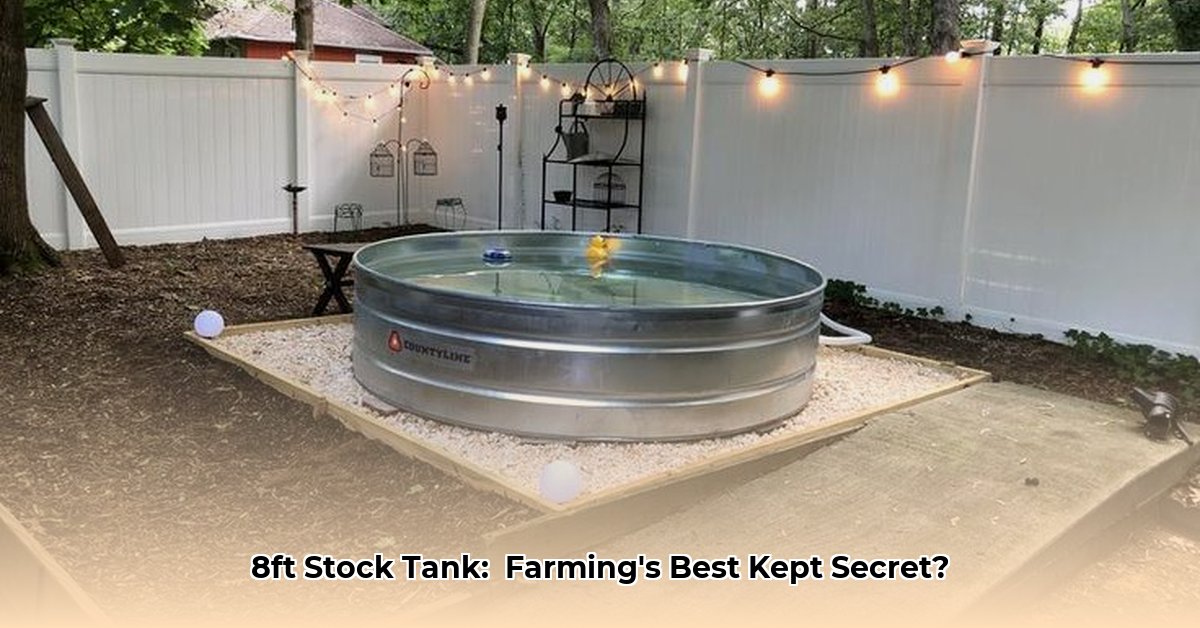
Choosing the right water storage solution is crucial for sustainable farming. For more information on galvanized steel options, see our galvanized steel tanks. Tractor Supply offers 8-foot stock tanks in two materials: galvanized steel and plastic (high-density polyethylene or HDPE). This guide compares both, helping you choose the best option for your farm's needs and environmental goals.
Steel vs. Plastic: A Material Comparison for Sustainable Water Storage
The primary difference lies in the tank material: robust galvanized steel or durable HDPE plastic. Both typically hold around 250 gallons in an 8ft x 2ft configuration, but their lifespans, environmental impacts, and costs vary significantly.
Steel tanks, like a sturdy barn, offer longevity. With proper maintenance, they can last over a decade. Plastic tanks, while more affordable initially, generally last 5-7 years before showing significant wear. This initial cost savings might be offset by the need for more frequent replacements.
Manufacturing processes also differ. Steel tank production involves zinc coating, impacting the environment. Plastic tank manufacturing uses less energy initially, seeming more eco-friendly. However, plastic originates from petroleum, a non-renewable resource, and its disposal presents waste challenges.
Long-Term Costs and Environmental Considerations: A Balanced Perspective
Steel tanks have a higher upfront cost, but their extended lifespan reduces the long-term expense of frequent replacements. Plastic tanks offer lower initial investment, but the cumulative cost over several replacements might equal or exceed that of a steel tank.
Sustainability is paramount. Both steel and plastic are recyclable; however, recycling success depends heavily on local infrastructure. Steel recycling is more established; plastic recycling rates are often lower. Steel production is energy-intensive and generates greenhouse gases. Plastic production, while less energy-intensive, relies on a non-renewable resource. Responsible disposal is crucial regardless of the chosen material. The overall environmental impact also depends on manufacturing location, transportation distance, and disposal methods.
Making Your Decision: Key Factors to Consider
Several factors influence your choice:
- Budget: Plastic tanks are significantly cheaper upfront.
- Lifespan: Steel tanks last considerably longer.
- Environmental Impact: Consider the entire lifecycle of each material.
- Intended Use: Food-grade plastic is preferable for drinking water.
- Climate: Extreme temperatures can impact both, but steel may be more susceptible depending on quality.
Actionable Steps for Sustainable Water Management on Your Farm
Follow these steps for optimal water management:
- Assess water needs: Determine your required storage capacity and available space.
- Budgeting: Factor in long-term costs, including maintenance and future replacements.
- Local Recycling: Check the availability of effective recycling programs for both steel and plastic in your area.
- Rainwater Harvesting: Integrate your stock tank with a rainwater collection system for enhanced sustainability.
- Maintenance: Regular cleaning and maintenance extend the tank's lifespan.
Beyond the Tank: Holistic Water Management Practices for Sustainable Farming
Sustainable water management extends beyond tank selection. Efficient irrigation techniques, like drip irrigation, minimize water waste. Coupled with rainwater harvesting, they optimize your water resources.
Consider the tank's eventual disposal. Planning for recycling or responsible disposal minimizes environmental impact. Underground tanks, while more expensive initially, minimize evaporation and contamination, offering long-term sustainability benefits.
Conclusion: A Sustainable Choice for Your Farm
Selecting a Tractor Supply 8-foot stock tank requires careful consideration of your farm’s specific needs, budget, and environmental goals. This guide provides a comprehensive comparison of steel and plastic options, emphasizing the importance of a holistic approach to water management for sustainable farming practices. Weighing the advantages and disadvantages of each option will lead to an informed decision that best serves your operation.